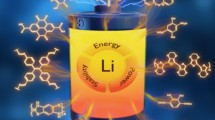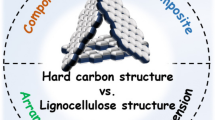Abstract
This paper presents a new and simple method for high-rate performance of PANI/Co3O4–CuO (PANI/MO–M′O′) raspberry via the sol–gel method and compares structural and electrochemical characteristics of both Co3O4–CuO (MO–M′O′) nanomatrix and PANI/MO–M′O′ raspberry nanoarray. Using the PANI/MO–M′O′ raspberry-inspired anode in lithium-ion batteries (LIBs) resulted in the improved electrochemical performances of cycling stability, discharge capacity, and rate capability compared with the MO–M′O′ nanomatrix. In addition, regarding anode material for LIBs, PANI/MO–M′O′ anode presented the specific capacity of 455.34 mAh g−1 at the current density of 1.0 A g−1 after 60 cycles. Further, the PANI/MO–M′O′ nanoarray produced a satisfied discharge capacity of 311.22 mAh g−1 at a density of 3.0 A g−1, as well as an appropriate cycle stability and rate capability. Finally, the improved electrochemical property of this unique organic–inorganic heterostructure (PANI/MO–M′O′ raspberry design) can be related to the avoid aggregation, an effective electric contact, improved electrochemical stability, and a lower charge-transfer resistance during cycling performance. These advantages are mainly because of the novel catalytic role of the PANI electron transfer in the PANI/MO–M′O′ raspberry as a new anode material.
Graphical abstract








Similar content being viewed by others
References
Jung H-G, Jang MW, Hassoun J, Sun Y-K, Scrosati B (2011) A high-rate long-life Li4Ti5O12/Li [Ni0.45Co0.1Mn1.45]O4 lithium-ion battery. Nat Commun 2:516
Zhang C, Xu D, Chen W, Ouyang D, Yu X (2017) Cockscomb-like Mn-doped MnxFe1–xCO3 as anode materials for a high-performance lithium-ion battery. J Appl Electrochem 47(2):157–166
Bradley TH, Frank AA (2009) Design, demonstrations and sustainability impact assessments for plug-in hybrid electric vehicles. Renew Sustain Energy Rev 13(1):115–128
Zheng J, Lin J, Chu R, Wu C, Zhang J, Chen Y, Zhang Y, Guo H (2017) ZnO nanoparticles anchored on nickel foam with graphene as morphology-controlling agent for high-performance lithium-ion battery anodes. J Appl Electrochem 47(8):969–978
Jiang Y, Zhang Y, Yan X, Tian M, Xiao W, Tang H (2017) A sustainable route from fly ash to silicon nanorods for high-performance lithium-ion batteries. Chem Eng J 330:1052–1059
Li Y, Levine AM, Zhang J, Lee RJ, Naskar AK, Dai S, Paranthaman MP carbon/tin oxide composite electrodes for improved lithium-ion batteries. J Appl Electrochem 48:1–7
Gao Q, Wang S, Tang Y, Giordano C (2012) Preparation of organic-inorganic hybrid Fe–MoOx/polyaniline nanorods as efficient catalysts for alkene epoxidation. Chem Commun 48(2):260–262
Zamani N, Modarresi-Alam AR, Noroozifar M (2018) Synthesis and application of phosphorus/Co3O4–CuO hybrid as high-performance anode materials for lithium-ion batteries. ACS Omega 3(4):4620–4630
Yang L, Wang S, Mao J, Deng J, Gao Q, Tang Y, Schmidt OG (2013) Hierarchical MoS2/polyaniline nanowires with excellent electrochemical performance for lithium-ion batteries. Adv Mater 25(8):1180–1184
Cho SI, Lee SB (2008) Fast electrochemistry of conductive polymer nanotubes: synthesis, mechanism, and application. Acc Chem Res 41(6):699–707
Allcock HR (1994) Inorganic-organic polymers. Adv Mater 6(2):106–115. https://doi.org/10.1002/adma.19940060203
Sindoro M, Feng Y, Xing S, Li H, Xu J, Hu H, Liu C, Wang Y, Zhang H, Shen Z (2011) Triple-layer (Au@ Perylene)@ polyaniline nanocomposite: unconventional growth of faceted organic nanocrystals on polycrystalline Au. Angew Chem Int Ed 50(42):9898–9902
Wang S, Gao Q, Zhang Y, Gao J, Sun X, Tang Y (2011) Controllable synthesis of organic-inorganic hybrid MoOx/polyaniline nanowires and nanotubes. Chem: Eur J 17(5):1465–1472
Kanatzidis MG, Wu CG, Marcy HO, Kannewurf CR (1989) Conductive-polymer bronzes. Intercalated polyaniline in vanadium oxide xerogels. J Am Chem Soc 111(11):4139–4141
Gangopadhyay R, De A (2000) Conducting polymer nanocomposites: a brief overview. Chem Mater 12(3):608–622
Xia X, Chao D, Qi X, Xiong Q, Zhang Y, Tu J, Zhang H, Fan HJ (2013) Controllable growth of conducting polymers shell for constructing high-quality organic/inorganic core/shell nanostructures and their optical-electrochemical properties. Nano Lett 13(9):4562–4568
Wu HB, Chen JS, Hng HH, Lou XWD (2012) Nanostructured metal oxide-based materials as advanced anodes for lithium-ion batteries. Nanoscale 4(8):2526–2542
Yin L, Zhang Z, Li Z, Hao F, Li Q, Wang C, Fan R, Qi Y (2014) Spinel ZnMn2O4 nanocrystal-anchored 3D hierarchical carbon aerogel hybrids as anode materials for lithium ion batteries. Adv Funct Mater 24(26):4176–4185
Wang Z, Zhou L (2012) Metal oxide hollow nanostructures for lithium-ion batteries. Adv Mater 24(14):1903–1911
Cabana J, Monconduit L, Larcher D, Palacin MR (2010) Beyond intercalation-based li-ion batteries: the state of the art and challenges of electrode materials reacting through conversion reactions. Adv Mater 22(35):E170–E192
Kang Y-M, Song M-S, Kim J-H, Kim H-S, Park M-S, Lee J-Y, Liu HK, Dou S (2005) A study on the charge-discharge mechanism of Co3O4 as an anode for the Li-ion secondary battery. Electrochim Acta 50(18):3667–3673
Yu Y, Chen CH, Shui JL, Xie S (2005) Nickel-foam-supported reticular CoO–Li2O composite anode materials for lithium ion batteries. Angew Chem Int Ed 44(43):7085–7089
Huang G, Zhang F, Du X, Qin Y, Yin D, Wang L (2015) Metal-organic frameworks route to in situ insertions of multiwalled carbon nanotubes in Co3O4 polyhedra as anode materials for lithium-ion batteries. ACS Nano 9(2):1592–1599
Huang H, Zhu W, Tao X, Xia Y, Yu Z, Fang J, Gan Y, Zhang W (2012) Nanocrystal-constructed mesoporous single-crystalline Co3O4 nanobelts with superior rate capability for advanced lithium-ion batteries. ACS Appl Mater Interfaces 4(11):5974–5980
Wu H, Yu G, Pan L, Liu N, McDowell MT, Bao Z, Cui Y (2013) Stable Li-ion battery anodes by in-situ polymerization of conducting hydrogel to conformally coat silicon nanoparticles. Nat Commun 4:1943
Hu L, Ren Y, Yang H, Xu Q (2014) Fabrication of 3D hierarchical MoS2/polyaniline and MoS2/C architectures for lithium-ion battery applications. ACS Appl Mater Interfaces 6(16):14644–14652
Kuang M, Li TT, Chen H, Zhang SM, Zhang LL, Zhang YX (2015) Hierarchical Cu2O/CuO/Co3O4 core-shell nanowires: synthesis and electrochemical properties. Nanotechnology 26(30):304002
Wang B, Wang G, Wang H (2014) In situ synthesis of Co3O4/Cu electrode and its high performance for lithium-ion batteries. Mater Lett 122:186–189
Sun Y, Xiao F, Liu X, Feng C, Jin C (2013) Preparation and electromagnetic wave absorption properties of core-shell structured Fe3O4-polyaniline nanoparticles. RSC Adv 3(44):22554–22559. https://doi.org/10.1039/C3RA43559H
Parvatikar N, Jain S, Kanamadi C, Chougule B, Bhoraskar S, Prasad M (2007) Humidity sensing and electrical properties of polyaniline/cobalt oxide composites. J Appl Polym Sci 103(2):653–658
Cui K, Cheng Y, Dai J, Liu J (2013) Synthesis, characterization and microwave absorption properties of La0.6Sr0.4MnO3/polyaniline composite. Mater Chem Phys 138(2):810–816
Park JC, Kim J, Kwon H, Song H (2009) Gram-scale synthesis of Cu2O nanocubes and subsequent oxidation to CuO hollow nanostructures for lithium-ion battery anode materials. Adv Mater 21(7):803–807. https://doi.org/10.1002/adma.200800596
Yin Z, Zheng Q (2012) Controlled synthesis and energy applications of one-dimensional conducting polymer nanostructures: an overview. Adv Energy Mater 2(2):179–218
Liu H-C, Yen S-K (2007) Characterization of electrolytic Co3O4 thin films as anodes for lithium-ion batteries. J Power Sources 166(2):478–484
Chen R, Wu Y, Kong XY (2014) Monodisperse porous LiFePO4/C microspheres derived by microwave-assisted hydrothermal process combined with a carbothermal reduction for high power lithium-ion batteries. J Power Sources 258:246–252
Li H, Huang X, Chen L, Wu Z, Liang Y (1999) A high capacity nano Si composite anode material for lithium rechargeable batteries. Electrochem Solid-State Lett 2(11):547–549
Xu K (2004) Nonaqueous liquid electrolytes for lithium-based rechargeable batteries. Chem Rev 104(10):4303–4418
Kasavajjula U, Wang C, Appleby AJ (2007) Nano-and bulk-silicon-based insertion anodes for lithium-ion secondary cells. J Power Sources 163(2):1003–1039
Pinson MB, Bazant MZ (2013) Theory of SEI formation in rechargeable batteries: capacity fade, accelerated aging and lifetime prediction. J Electrochem Soc 160(2):A243–A250
Nie M (2014) Anode solid electrolyte interphase (SEI) of lithium-ion battery characterized by microscopy and spectroscopy. The University of Rhode Island
Saadat S, Zhu J, Sim DH, Hng HH, Yazami R, Yan Q (2013) Coaxial Fe3O4/CuO hybrid nanowires as ultrafast charge/discharge lithium-ion battery anodes. J Mater Chem A 1(30):8672–8678
Mei W, Huang J, Zhu L, Ye Z, Mai Y, Tu J (2012) Synthesis of porous rhombus-shaped Co3O4 nanorod arrays grown directly on a nickel substrate with high electrochemical performance. J Mater Chem 22(18):9315–9321
Chen X, Zhang N, Sun K (2012) Facile fabrication of CuO 1D pine-needle-like arrays for super-rate lithium storage. J Mater Chem 22(30):15080–15084
Fu Y, Li X, Sun X, Wang X, Liu D, He D (2012) Self-supporting Co3O4 with lemongrass-like morphology as a high-performance anode material for lithium-ion batteries. J Mater Chem 22(34):17429–17431
Wang B, He X, Li H, Liu Q, Wang J, Yu L, Yan H, Li Z, Wang P (2014) Optimizing the charge transfer process by designing Co3O4@PPy@MnO2 ternary core-shell composite. J Mater Chem A 2(32):12968–12973
Hu L, Yan N, Chen Q, Zhang P, Zhong H, Zheng X, Li Y, Hu X (2012) Fabrication based on the Kirkendall effect of Co3O4 porous nanocages with an extraordinarily high capacity for lithium storage. Chem: Eur J 18(29):8971–8977
Rai AK, Anh LT, Gim J, Mathew V, Kang J, Paul BJ, Singh NK, Song J, Kim J (2013) Facile approach to synthesize CuO/reduced graphene oxide nanocomposite as anode materials for a lithium-ion battery. J Power Sources 244:435–441. https://doi.org/10.1016/j.jpowsour.2012.11.112
Modarresi-Alam AR, Amirazizi HA, Movahedifar F, Farrokhzadeh A, Asli GR, Nahavandi H (2015) The first report of polymerization and characterization of aniline bearing chiral alkyl group on ring via a covalent bond; poly [(±)-2-(sec-butyl) aniline]. J Mol Struct 1083:17–26
Taberna P-L, Mitra S, Poizot P, Simon P, Tarascon J-M (2006) High rate capabilities Fe3O4-based Cu nano-architectured electrodes for lithium-ion battery applications. Nat Mater 5(7):567–573
Poizot P, Laruelle S, Grugeon S, Dupont L, Tarascon J (2000) Nano-sized transition-metal oxides as negative-electrode materials for lithium-ion batteries. Nature 407(6803):496–499
Su C, Bu X, Xu L, Liu J, Zhang C (2012) A novel LiFePO4/graphene/carbon composite as a performance-improved cathode material for lithium-ion batteries. Electrochim Acta 64:190–195
Zhang Y, Chen L, Ou J, Wang J, Zheng B, Yuan H, Guo Y, Xiao D (2013) Improving the performance of a LiFePO4 cathode based on electrochemically cleaved graphite oxides with high hydrophilicity and good conductivity. J Mater Chem A 1(27):7933–7941
Shu H, Wang X, Wen W, Liang Q, Yang X, Wei Q, Hu B, Liu L, Liu X, Song Y (2013) Effective enhancement of electrochemical properties for LiFePO4/C cathode materials by Na and Ti co-doping. Electrochim Acta 89:479–487
Cheng H, Lu ZG, Deng JQ, Chung C, Zhang K, Li YY (2010) A facile method to improve the high rate capability of Co3O4 nanowire array electrodes. Nano Res 3(12):895–901
Ahn D, Koo Y-M, Kim MG, Shin N, Park J, Eom J, Cho J, Shin TJ (2010) Polyaniline nanocoating on the surface of layered Li [Li0.2Co0.1Mn0.7]O2 nanodisks and enhanced cyclability as a cathode electrode for a rechargeable lithium-ion battery. J Phys Chem C 114(8):3675–3680
Wang J, Zhang Q, Li X, Xu D, Wang Z, Guo H, Zhang K (2014) Three-dimensional hierarchical Co3O4/CuO nanowire heterostructure arrays on nickel foam for high-performance lithium-ion batteries. Nano Energy 6:19–26
Shi L, Fan C, Fu X, Yu S, Qian G, Wang Z (2016) Carbonate-assisted hydrothermal synthesis of porous hierarchical Co3O4/CuO composites as high capacity anodes for lithium-ion batteries. Electrochim Acta 197:23–31
Acknowledgements
The authors acknowledge the financial support of the Graduate Council of the University of Sistan and Baluchestan and the National Nanotechnology Initiative funded by the Iranian government. The authors are also grateful to the Renewable Energy Research Center (RERC), Amirkabir University of Technology (Tehran, Iran), for the financial support of the present research.
Author information
Authors and Affiliations
Corresponding authors
Additional information
Publisher’s Note
Springer Nature remains neutral with regard to jurisdictional claims in published maps and institutional affiliations.
Electronic supplementary material
Below is the link to the electronic supplementary material.
Rights and permissions
About this article
Cite this article
Zamani, N., Modarresi-Alam, A.R., Noroozifar, M. et al. The improved performance of lithium-ion batteries via the novel electron transport catalytic role of polyaniline (PANI) in PANI/Co3O4–CuO raspberry as new anode material. J Appl Electrochem 49, 327–340 (2019). https://doi.org/10.1007/s10800-019-01286-2
Received:
Accepted:
Published:
Issue Date:
DOI: https://doi.org/10.1007/s10800-019-01286-2




